WHAT'S NEW:
Deepsea Image Galleries on Multimedia page
(posted 9/15/98)
Eruption Confirmed!
New lava (rumbleometer stuck in flow) SE rift zone
(posted 9/1/98)
BACKGROUND:
Technology (ROV, ships, etc.)
Other 1998 Axial cruise reports
EXPEDITION:
Science Objectives
Calendar
Today's Science News
Participant Perspective
Teacher Logbook
EDUCATION:
Curriculum
Teacher Observations
Questions/Answers from sea
MULTIMEDIA:
(video clips, animations, sounds)
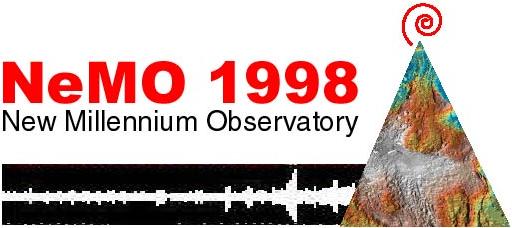
Logbook
September 18, 1998
September 18, 1998
Contents:
Science Report
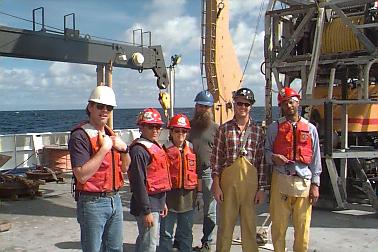
After 43 hours downtime due to weather, ROPOS is back in the water. During the
time we were unable to dive with ROPOS other operations took place. One
CTD
cast was made, and five
rockcores were successfully completed. We're back in
the water now. Expect a cruise report from the chief scientist tomorrow.
Photo shows the
ship's deck crew;
responsibilities include small boat operations and all gear going in & out of the water. (photo: NOAA Vents G. Williamson)
Listing of all Science News postings
Life at Sea: Participant Perspective
Elizabeth Guenther
Moss Landing Marine Laboratory and
Stacey Maenner
NOAA Corps Officer,
Vents Prorgram
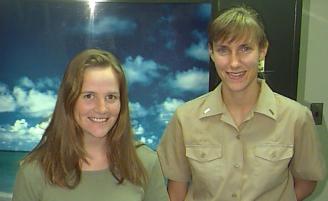
Hello everyone, it is September 18, 1998. We are reaching the end of our vents cruise now. We only have 2 days left and only 1 of those will be used for diving with the submersible ROPOS. It has been a very productive cruise for all those involved. I myself (Elizabeth Guenther, Moss Landing Marine Laboratory) am almost done with my work. Today I will be receiving my last set of samples from the Fluid Sampler. I look at the chemistry of the water samples, specifically the salinity, nitrate and sulfide concentrations at the various vent sites. My work is different from that of the other scientists on board in that I am working on a new method for measuring those three things. Right now it is still a work in progress, but I can tell you that it will make things much easier in the future of vent chemistry analyses if it works as well as I hope.
That isn't all I have been doing on this cruise though. I have been helping
with the video taping of the dives. My watch is from 4am to 8am every day. Of
course the ROPOS isn't always in the water at that time so I get a break once in
a while. When I am not busy doing work I find time to relax by watching a movie
in the TV room. There is a wide selection of movies available and they play 2
movies every night for anyone who wants to relax a little and get away from the
work that keeps them so busy the rest of the time.
Elizabeth Guenther
Hello, my name is Stacy Maenner and I am a NOAA Corps Officer currently assigned to the Pacific Marine Environmental Laboratory. While Elizabeth is helping with the video tapes of the dives, I am trying to log all the comments that are being made in the ROPOS room by all the scientists. It can be quite a challenge at times when everyone gets really excited over new discoveries and starts talking at once. I need to log everything from new findings to pictures of Mr. Potato Head to aggressive sulfide worms that make the WWF look wimpy! My main responsibility on the cruise, however, is assisting Gary Massoth with SUAVE (see August 30). SUAVE provides a lot of interesting and exciting real time data that many scientists use to understand more about the life at hydrothermal vents. I also analyze water samples collected from the CTDT/Rosette for trace levels of iron and manganese. If we are fortunate, then the samples were taken from a hydrothermal plume. For more information on CTDT and hydrothermal plumes, see Betsy McLaughlin-West (29 August). I have really enjoyed my time on this cruise. I still find it fascinating that we are able to guide a remotely operated vehicle more then a mile deep in the ocean and at the same time make observations such as hot fluid venting from the seafloor, life surviving in extreme environments and new lava formations.
Listing of all Perspectives postings
Teacher At Sea Logbook
September 18 - 0900
The last working day is here. The wind is still blowing, ROPOS sits on the aft deck, and we are officially at the point of wondering if, and hoping that we can get one more dive in later today. The scientists have had such a productive cruise, it would be great if they could complete the last couple of objectives. That all depends on what the weather holds over the next twelve hours.
While I wait to see if we can deploy ROPOS, I thought it might be a good idea to
take a quick look back over this cruise and try to express once more the
admiration I have for the women and men who have spent the last 27 days
unlocking the secrets of Axial Seamount and the environment that surrounds the
vents. I have often reported on the almost "science fiction" nature of the
technology that was used. It's not just
ROPOS, although that instrument is a
wonder in and of itself. It is the various instruments that ROPOS carries to
the bottom that actually gather the data, and there is not a single device, from
water sampling bottles to the highly sophisticated
SUAVE apparatus that can be
purchased at your local electronics store or home shoppers club. These
instruments are the result of years of testing, tweaking, and re-testing. I
arrived on board just as the wave was cresting. I have seen ocean research when
it is the best it can be. The weather cooperates, and everything works. It's
been a great show. Bob Embley, chief scientist, and the whole scientific
contingent can take a deep bow.
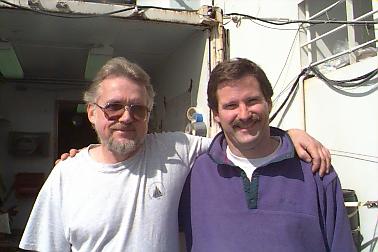
Bob Embley and
Bill Chadwick (photo right) have worked long hours on improving the
Air Force special delivery notwithstanding, when you come to sea you bring
supplies and tools and ingenuity, and you hope you can make it work. When
something doesn't work, you try to think of a way to make it work. The
electronics for the fluid sampler came in by special delivery, but when the pump
subsequently gave up,
Dave Butterfield and his crew figured out a way to use a
If, as a student, you are ever tempted to think that you can ease back because
technology will take up the slack, you are sadly mistaken. I know, because I've
been there, done that. A little college in Oregon is currently running one of
the best advertisements I have ever seen. The thrust of the message is, "Beware
of those who give you a an 'A', because they are telling you that you have
arrived, that you can go home and relax. Beware of the 'A'. You have to think
about it, but that is a very powerful message My students seldom understood why
I was very disappointed if anyone got a 100% on one of my science tests. I
simply wanted every student to understand that he/she had not achieved
everything that could be achieved. There aren't any 100% marks in life. Never
have been, never will be.
Given the direction most American public schools have gone the past decade,
fewer and fewer students are getting this message. Everyone has to be a
success. Every parent needs a bumper sticker proclaiming progeny who have been
named "student of the month." And to accommodate that need we have 10 students
of the month every month, and no repeats allowed. That watered down approach to
education will not replace the scientists aboard this ship. The kid with a
burning passion to learn, who may never be "student of the month" because she
elected not to try out for cheerleader, or elected to pursue a specific goal to
the detriment of the overall grade average, is the one who will be the next
generation of ocean scientist. Believe it.
Tomorrow I will try to hit the highlights of what has been learned in this past
month. It is difficult to see how all that has happened can be distilled into a
single commentary, but that's why they are paying me the big bucks. (Hmmm.
Maybe for the benefit of any NSF readers out there I should speak the truth. My
work out here has been as a volunteer. The truth is, I'd have paid for the
opportunity.)
Logbook of all Teacher At Sea postings
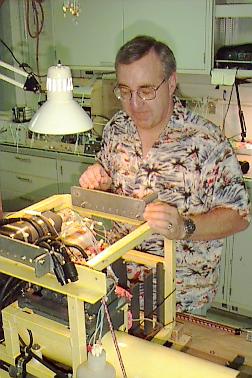 pump from another device to save the day. When you really look inside SUAVE, or
any of the other fabulous "toys" that we have on board, you see that none of
this could happen without the brilliant and dedicated minds of the scientists
who build the machines.
Gary Massoth and all the others who have spent the
better part of a decade getting SUAVE to its present state deserve the
admiration of us all. There simply is no substitute for the well-schooled human
mind.
pump from another device to save the day. When you really look inside SUAVE, or
any of the other fabulous "toys" that we have on board, you see that none of
this could happen without the brilliant and dedicated minds of the scientists
who build the machines.
Gary Massoth and all the others who have spent the
better part of a decade getting SUAVE to its present state deserve the
admiration of us all. There simply is no substitute for the well-schooled human
mind.
Question/Answer of the Day
Send Your Question to NeMO
(oar.pmel.vents.webmaster@noaa.gov)
Back to Calendar